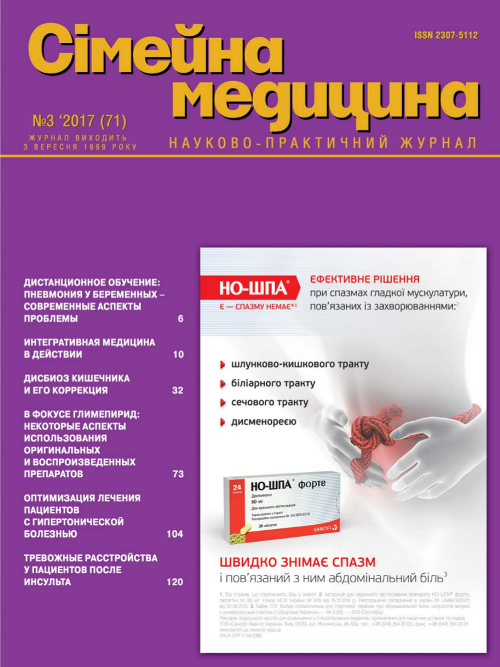Attenuation coefficient measurement as a method for following up of nonalcoholic fatty liver disease in patients with type 2 diabetes mellitus
##plugins.themes.bootstrap3.article.main##
Abstract
Diabetes mellitus is the urgent problem of modern endocrinology. Nonalcoholic fatty liver disease (NAFLD) is one of the reasons of disability, invalidity, mortality of patients with diabetes and is characterized by excessive accumulation of liver fat due to insulin resistance and is determined by the presence of steatosis more than in 5% of hepatocytes. That’s why new noninvasive and economically affordable methods of diagnosis and following up patients with NAFLD have to be invented and implemented.
The objective: is diagnosis of specificity of NAFLD progression in patients with type 2 diabetes mellitus (T2DM) with the help of attenuation coefficient measurement (ACM).
Patients and methods. Investigation was conducted in Kyiv endocrine centre in 2015–2017. 105 patients have been followed up. Simultaneous US was made all 105 patients on device Soneus P7 (Ultrasign, Ukraine) and included В-regime of abdominal cavity, dopplerography ( metry), strain and share wave elastofraphy (-metry), evaluation of hepatorenal index, steatography (-metry) with the help of ACM. Anthropometric data and biochemical data of venous blood were also conducted in these patients.
Results. There was found statistically significant correlation between ACM and the lipidogram, resistance to insulin, level of alanine aminotransferase (ALT) and anthropometric data (waist circumference (WC)), ratio WC/thigh circumference (TC)).
Conclusions. It was proved in our research that ACM can be used for diagnosis of NAFLD, control of its progression and following patients up due to the correlation of ACM with the data of lipid and carbohydrate metabolism, inflammation of liver tissue and anthropometric data.
##plugins.themes.bootstrap3.article.details##

This work is licensed under a Creative Commons Attribution 4.0 International License.
Authors retain the copyright and grant the journal the first publication of original scientific articles under the Creative Commons Attribution 4.0 International License, which allows others to distribute work with acknowledgment of authorship and first publication in this journal.
References
Atlas IDF 2015.
EASL-EASD-EASO Clinical Practice Guidelines for the management of nonalcoholic fatty liver disease. J of Hepat 2016;64:1388–1402.
Gaggini M., Morelli M., Buzzigoli E., DeFronzo R.A., Bugianesi E., Gastaldelli A. Non alcoholic fatty liver disease (NAFLD) and its connection with insulin resistance, dyslipidemia, atherosclerosis and coronary heart disease. Nutrients 2013;5:1544–1560.
Koliaki C, Szendroedi J, Kaul K, Jelenik T, Nowotny P, Jankowiak F, et al. Adaptation of hepatic mitochondrial function in humans with nonalcoholic fatty liver is lost in steatohepatitis. Cell Metab 2015;21:739–746.
Yki Jarvinen H. Non alcoholic fatty liver disease as a cause and a conse quence of metabolic syndrome. Lancet Diabetes Endocrinol 2014;2:901–910.
Дынник О.Б., Федусенко А.А., Кобyляк Н.Н., Линская А.В., 6 измерений ультразвуковой диагностики диффузных заболеваний печени. Променева діагностика, променева терапія 2016;3 4:69 – 84.
Ghouri N, Preiss D, Sattar N. Liverenzymes, nonalcoholic fatty liverdisease, and incident cardiovascular disease: a narrative review and clinical perspective of prospective data. Hepatology 2010; 52: 1156–1161.
Kotronen A, Juurinen L, Hakkarainen A, Westerbacka J, Corner A, Bergholm R, et al. Liver fat is increased in type 2 diabetic patients and underestimated by serum alanine aminotransferase compared with equally obese nondiabetic subjects. Diabetes Care 2008; 31: 165–169.
Bedogni G, Miglioli L, Masutti F, Tiribelli C, Marchesini G, Bellentani S. Prevalence of and risk factors for nonalcoholic fatty liver disease: the Dionysos nutrition and liver study. Hepatology 2005;42:44–52.
Frith J, Day CP, Robinson L, Elliott C, Jones DE, Newton JL. Potential strategies to improve uptake of exercise interventions in non alcoholic fatty liver disease. J Hepatol 2010;52:112–116.





